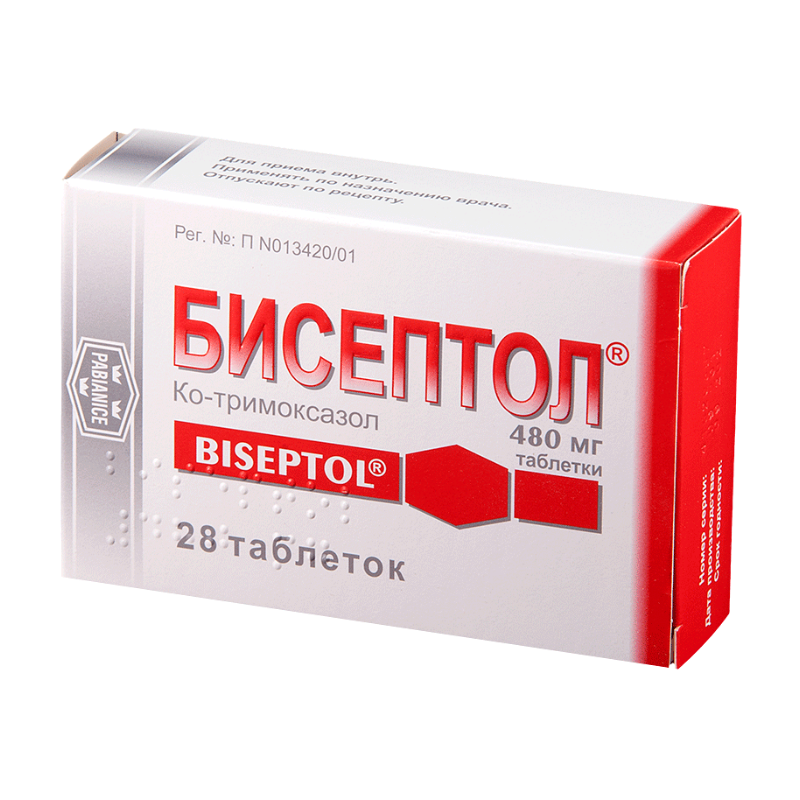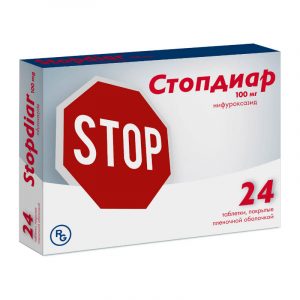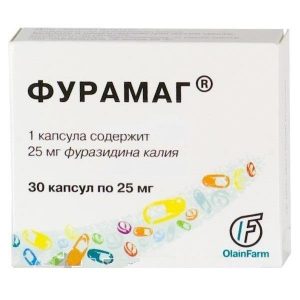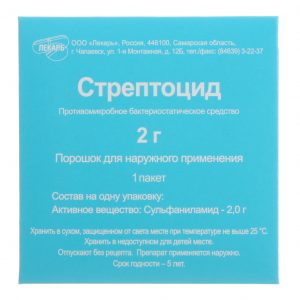Description
Release form
Tablets
Packaging
In a blister pack of 20 tablets. In the package 1 blister.
Pharmacological action
Combined antibacterial drug, contains sulfamethoxazole and trimethoprim.
Sulfamethoxazole, similar in structure to PABA, disrupts the synthesis of dihydrofolic acid in bacterial cells, preventing the inclusion of PABA in its molecule.
Trimethoprim enhances the action of sulfamethoxazole, disrupting the restoration of dihydrofolic acid into tetrahydrofolic acid, the active form of folic acid responsible for protein metabolism and microbial cell division.
Is a broad-spectrum bactericidal drug.
Active against gram-positive aerobic bacteria: Streptococcus spp., Including Streptococcus pneumoniae (hemolytic strains are more sensitive to penicillin), Staphylococcus spp., Bacillus anthracis, Listeria spp., Nocardia asteroides, Enterococcus faecalis, Mycobacterium spp. (including Mycobacterium leprae, excluding Mycobacterium tuberculosis) gram-negative aerobic bacteria: Neisseria meningitidis, Neisseria gonorrhoeae, Escherichia coli (including enterotoxogenic strains), Salmonella spp. (including Salmonella typhi and Salmonella paratyphi) Vibrio cholerae, Haemophilus influenzae (including ampicillin-resistant strains), Bordetella pertussis, Klebsiella spp., Proteus spp., Pasteurella spp., Francisella tularensis, Brucella spppp., spp. ,pp. pneumopbila, Providencia, some species of Pseudomonas (except Pseudomonas aeruginosa), Serratia marcescens, Shigella spp., Yersinia spp., Morganella spp., And also in relation to Chlamydia spp. (including Chlamydia trachomatis, Chlamydia psittaci) for gram-positive anaerobes: Actinomyces israelii for protozoa: Plasmodium spp., Toxoplasma gondii pathogenic fungi: Coccidioides immitis, Histoplasma capsulatum, Pneumocystishia carinii.
Resistant to the drug: Corynebacterium spp., Pseudomonas aeruginosa, Mycobacterium tuberculosis, Treponema spp., Leptospira spp., viruses.
Inhibits the activity of E. coli, which leads to a decrease in the synthesis of thiamine, riboflavin, nicotinic acid and other B vitamins in the intestine.
The duration of the therapeutic effect is 7 hours.
Pharmacokinetics
Absorption
After oral administration, the active substances are completely absorbed from the digestive tract. Cmax in plasma is reached within 1-4 hours after ingestion.
Distribution
Trimethoprim penetrates well into the tissues and biological environments of the body: lungs, kidneys, prostate, bile, saliva, sputum, cerebrospinal fluid. The binding of trimethoprim to plasma proteins is 50% sulfamethoxazole – 66%.
Excretion of
T1 / 2 of trimethoprim – 8.6-17 hours, sulfamethoxazole – 9-11 hours. The main route of excretion is the kidneys, while trimethoprim is excreted unchanged up to 50% sulfamethoxazole – 15-30% in active form.
Indications
Treatment of infectious and inflammatory diseases caused by microorganisms sensitive to the drug:
– respiratory tract infections (including bronchitis, pneumonia, lung abscess, pleural empyema)
– otitis media, sinusitis
– urinary tract infections including pyelonephritis, urethritis, salpingitis, prostatitis)
– gonorrhea
– gastrointestinal infections (including typhoid fever, paratyphoid, bacterial dysentery, cholera, diarrhea)
– infections of the skin and soft tissues (including furunculosis, pyoderma).
Contraindications
– established damage to the liver parenchyma
– severe impaired renal function in the absence of the ability to control the concentration of the drug in blood plasma
– severe renal failure (CC less than 15 ml / min)
– severe blood diseases (aplastic anemia, B12-deficiency anemia, agranulocytosis, leukopenia, megaloblastic anemia, folic acid deficiency anemia)
– hyperbilirubinemia in children
– glucose-6-phosphate dehydrogenase deficiency (risk of hemolysis)
– pregnancy
– lactation
(for children under 3 years of age)
– hypersensitivity to the components of the drug
– hypersensitivity to sulfonamides.
With caution, a drug is prescribed for folic acid deficiency in the body, bronchial asthma, thyroid diseases.
Use during pregnancy and lactation
Biseptol is contraindicated in pregnancy and lactation (breastfeeding).
Special instructions
With caution, a drug is prescribed for folic acid deficiency in the body, bronchial asthma, thyroid diseases, a burdened allergic history.
It is not recommended to use the drug for tonsillitis and pharyngitis caused by -hemolytic group A streptococcus, due to the widespread resistance of the strains.
With long-term (more than a month) courses of treatment, regular blood tests are necessary, since there is a possibility of hematological changes (most often asymptomatic). These changes can be reversed with the appointment of folic acid (3-6 mg / day), which does not significantly violate the antimicrobial activity of the drug. Particular caution is necessary in the treatment of elderly patients or patients with a suspicion of an initial lack of folato
Composition
1 tablet contains:
Active ingredients: sulfamethoxazole – 400 mg, trimethoprim – 80 mg.
Excipients: potato starch, talc, magnesium stearate, polyvinyl alcohol, methyl parahydroxybenzoate, propyl parahydroxybenzoate, propylene glycol.
Dosage and administration of
The drug is taken orally after a meal with plenty of fluids. The dose is set individually.
For children aged 3 to 5 years, the drug is prescribed at 240 mg (2 tab. 120 mg) 2 times / day for children aged 6 to 12 years – 480 mg (4 tab. 120 mg or 1 tab. 480 mg) 2 times / day.
In pneumonia, the drug is prescribed at the rate of 100 mg sulfamethoxazole per 1 kg of body weight / day. The interval between doses is 6 hours, the duration of administration is 14 days.
With gonorrhea, the dose of the drug is 2 g (in terms of sulfamethoxazole) 2 times / day with an interval between doses of 12 hours.
Adults and children over 12 years of age are prescribed 960 mg 2 times / day, with long-term therapy – 480 mg 2 times / day
Duration of treatment – from 5 to 14 days. In severe cases of the disease and / or in chronic infections, a single dose may increase by 30-50%.
If the duration of the course of therapy is more than 5 days and / or an increase in the dose of the drug, it is necessary to control the picture of peripheral blood. If pathological changes occur, folic acid should be prescribed in a dose of 5-10 mg / day.
If you miss a dose, take the drug as soon as possible. If the next dose is approaching, skip the previous dose. Do not take a double dose in order to compensate for the missed.
In patients with renal insufficiency with a CC of 15-30 ml / min, the standard dose of the drug should be reduced by 50%, with a CC of less than 15 ml / min, the drug is not recommended.
Side effects
The drug is generally well tolerated.
From the nervous system: headache, dizziness in some cases – aseptic meningitis, depression, apathy, tremor, peripheral neuritis.
From the respiratory system: bronchospasm, suffocation, cough, pulmonary infiltrates.
From the digestive system: nausea, vomiting, decreased appetite, diarrhea, gastritis, abdominal pain, glossitis, stomatitis, cholestasis, increased activity of hepatic transaminases, hepatitis, sometimes with cholestatic jaundice, hepatonecrosis, pseudomembranous enterocolitis, pancreatitis.
From the hemopoietic system: leukopenia, neutropenia, thrombocytopenia, agranulocytosis, megaloblastic anemia, aplastic and hemolytic anemia, eosinophilia, hypoprothrombinemia, methemoglobinemia.
From the urinary system: polyuria, interstitial nephritis, impaired renal function, crystalluria, hematuria, increased urea concentration, hypercreatininemia, toxic nephropathy with oliguria and anuria.
From the musculoskeletal system: arthralgia, myalgia.
Allergic reactions: pruritus, photosensitivity, urticaria, drug fever, rash, erythema multiforme exudative (including Stevens-Johnson syndrome), toxic epidermal necrolysis (Lyell syndrome), exfoliative dermatitis, allergic myocarditis, fever, angioedema, hyperemia of the sclera.
From the side of metabolism: hypoglycemia, hyperkalemia, hyponatremia.
Drug Interactions
With the simultaneous use of the drug with thiazide diuretics, there is a risk of thrombocytopenia and bleeding (a combination is not recommended).
Co-trimoxazole increases the anticoagulant activity of indirect anticoagulants, as well as the effects of hypoglycemic drugs and methotrexate.
Co-trimoxazole reduces the hepatic metabolism of phenytoin (increases its T1 / 2 by 39%) and warfarin, enhancing their effect.
Rifampicin reduces T1 / 2 of trimethoprim.
With the simultaneous use of pyrimethamine in doses exceeding 25 mg / week, the risk of developing megaloblastic anemia increases.
With the simultaneous use of diuretics (often thiazide), the risk of thrombocytopenia increases.
Benzocaine, procaine, procainamide (like other drugs that hydrolyze PABA) reduce the effectiveness of Biseptol ®.
Between diuretics (including thiazides, furosemide) and oral hypoglycemic agents (sulfonylurea derivatives) on the one hand, and antibacterial agents of the sulfonamide group – on the other hand, the development of a cross allergic reaction is possible.
Phenytoin, barbiturates, PASK enhance the manifestations of folic acid deficiency with simultaneous use with Biseptolum.
Salicylic acid derivatives enhance the action of Biseptolum.
Ascorbic acid, hexamethylenetetramine (like other drugs that acidify urine) increase the risk of crystalluria during the use of Biseptolum.
Colestyramine reduces absorption while taking with other drugs, so it should be taken 1 hour after or 4-6 hours before taking co-trimoxazole.
When used simultaneously with drugs that inhibit bone marrow hematopoiesis, the risk of developing myelosuppression increases.
Biseptol ® may increase the concentration of digoxin in blood plasma in some elderly patients.
Biseptol ® may decrease the effectiveness of tricyclic antidepressants.
In patients after kidney transplantation with the simultaneous use of co-trimoxazole and cyclosporine, there is a passing violation of the function of the transplanted kidney, which is manifested by an increase in serum creatinine concentrations, which is probably caused by trimethoprim.
Biseptol ® reduces the effectiveness of oral contraception (inhibits the intestinal microflora and reduces the intestinal-hepatic circulation of hormones).
Overdose
Symptoms: Sulfonamide overdose – no appetite, intestinal colic, nausea, vomiting, dizziness, headache, drowsiness, loss of consciousness, fever, hematuria, crystalluria are also possible. Later, bone marrow and jaundice oppression may develop.
After acute trimethoprim poisoning, nausea, vomiting, dizziness, headache, depression, disorder of consciousness, depression of bone marrow function are possible.
It is unknown what dose of co-trimoxazole can be life-threatening.
Chronic poisoning: the use of co-trimoxazole at high doses for prolonged periods can lead to inhibition of bone marrow function, manifested by thrombocytopenia, leukopenia or megaloblastic anemia.
Treatment: cancellation of the drug and taking measures to remove it from the gastrointestinal tract (to wash the stomach not later than 2 hours after taking the drug or cause vomiting), heavy drinking if diuresis is insufficient, and renal function is preserved. Introduce calcium folinate (5-10 mg / day). An acidic urine environment accelerates the elimination of trimethoprim, but may also increase the risk of crystallization of sulfonamide in the kidneys.
Blood count, plasma electrolyte composition and other biochemical parameters should be monitored. Hemodialysis is moderately effective and peritoneal dialysis is ineffective.
Storage conditions
The product should be stored out of the reach of children at a temperature not exceeding 25 ° C.
Shelf life
5 years.
Deystvuyushtee substance
Co-trimoxazole Sulyfametoksazol, Trimethoprim
Terms and conditions
Prescription
Dosage form
tablets
Prescribing
Prescribing
Children prescribed by a doctor, Children over 6 years old, For adults prescribed by a doctor




